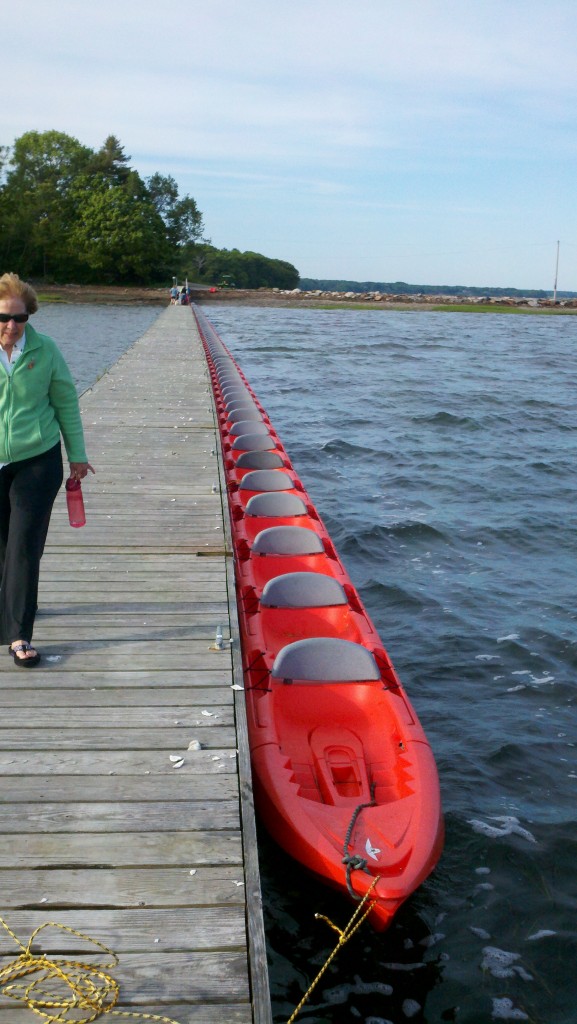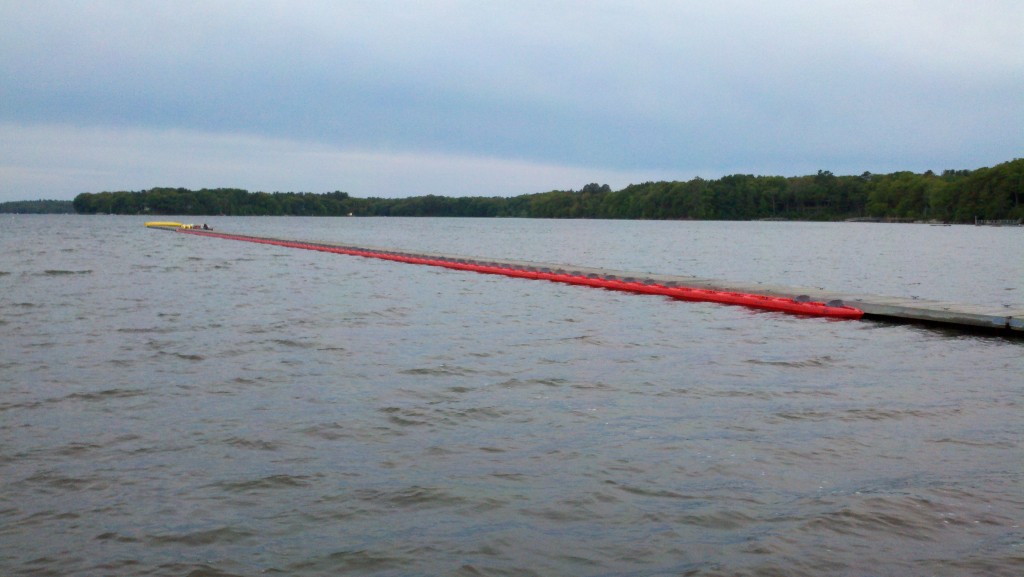
TrailCross.com working with Kenco Work and Play Outfitters in Kingston, NY is sponsoring a 10-person public paddle of the Esopus Creek as part of Riverkeeper’s Creek Week. Take a look: http://www.riverkeeper.org/news-events/events/rvk-events/kayak-lower-esopus/
It’s a beautiful day in Vermont! We are very proud of our first Eastern Outdoor Rep Association booth. We are located in the Snow Shed Lodge, booth 09, today through Wednesday. If you are a retailer, come check out our five lines, if you are a consumer, and can sneak into the show, come by for a great deal on some samples.

Hello. I hope everyone is having a great summer!
Recently, I came across the wonderful new video series about public land from the Center for American Progress and the Sierra Club. This three part series, although only a few minutes long, smartly describes how the over-development or unregulated use of public land can damage the land and the communities that count on it. I can go on about the important subject, but these videos do the talking themselves. Enjoy!
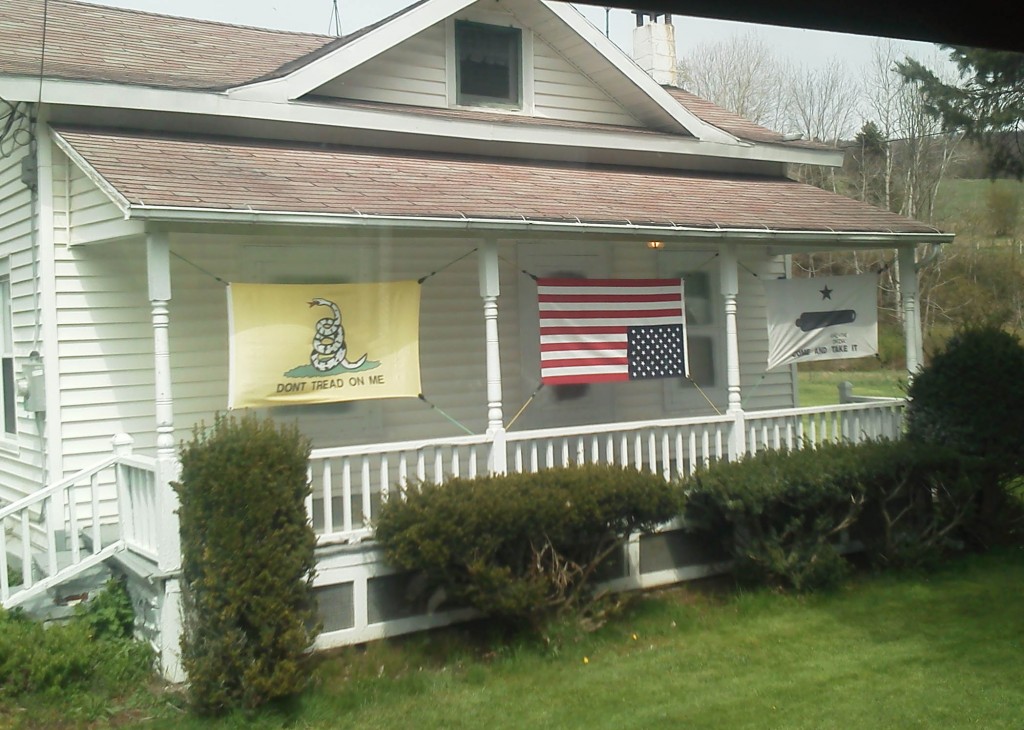
A citizen and large farm owner local to the Dimock, Pennsylvania area, who has vowed not to lease his land to the gas companies. The American flag upside down is used traditionally as a sign of distress or an attack on individual liberty.
Dimock, PA – Last Wednesday, I traveled to the epicenter of the fracking debate in Northeastern Pennsylvania to determine with my own eyes whether the fracking industry is helping or hurting our country. I traveled to fifteen operating fracking sites in the towns of Dimock, Montrose, and Springville, Pennsylvania. What I encountered was divided communities and shattered landscapes. These communities and the natural environment are suffering because our government has allowed this industry to “learn on the job” with regard to their environmental impact. Our municipal, state, and federal governments have been on a strict austerity program as a result of the hype around government deficits; therefore, immediate government resources to properly evaluate, regulate, monitor, and enforce regulations on the fracking industry are limited, if not altogether absent.
I believe in the promise of clean-burning natural gas as an appropriate counter to oil, coal, and nuclear as we build our renewable energy sector; however, the natural gas industry, specifically the fracking industry, will not succeed if the industry is left to self monitor, as we have seen in our examples in the oil industry, such as the BP Oil spill in the Gulf of Mexico; additionally, and more importantly, it may turn out once properly regulated to avoid major environmental and community impact, fracking cannot be done profitably, and I am sure the investors in the fracking industry are not investing to break even. As I describe below from my personal experience and research, current environmental damage and the resulting, mounting lawsuits, may shut down the promise of shale natural gas before it even has a chance to succeed.
Dimock, Pennsylvania is a one-light town of roughly 1400 people. The town is located about 35 miles from both Binghamton, New York and Scranton, Pennsylvania. The town is 24.9 square miles, and it has 24 wells drilled and another 19 permitted within a two-mile radius of its small town center. To see a complete map of all the wells drilled and permitted in Pennsylvania, please click HERE. You can type “Dimock” in the map’s search bar to focus in on the area I am describing in this article.
The first thing I noticed about this small town was its overwhelming traffic. There are one to three trucks (typically in a line) passing through the town center every five to ten seconds. These are water trucks, dump trucks, chemical trucks, service trucks, and equipment trucks. These trucks are very loud, as they are constantly pulling their jake brakes on these hilly, narrow, local roads. In addition to the noise pollution, the trucks produce a lot of air pollution from their spent fuel and from the dust they kick up from the roads. The roads are old, and I can tell they are not constructed to handle heavy truck traffic. In several places I passed, there were road crews repairing the damaged roads, and in one case, repairing a damaged bridge. The two roads that cross in the center of town at the single flashing light are asphalt, but most of the roads to the fracking sites are gravel roads or dirt roads (this is were the majority of the dust comes from).
When I approached the first fracking site, I was greeted by a friendly smile from a Mexican immigrant who was directing the truck traffic on the dirt road that entered the well site. I asked him were he was from and how long he had been in Dimock. He told me he was from Mexico and he did not live in Dimock. He was reluctant to talk to me any further because his co-workers were watching our conversation from the well site. In approaching the well site, I noticed 100% of the employees were people of color; all Hispanic, even the foremen in the new, white pickup truck. I did not talk to any of the other employees, as they looked nervous and suspicious of me and the rest of the group with which I was traveling. I was shocked to see there were no white employees given that Dimock, just like most of Northeastern Pennsylvania, has a large white majority. According to the U.S. census of 2000, Dimock has a 98.64% white population and a 0.36% Hispanic or Latino population.
The well site was a completed and functioning gas well. The well site construction, the well drilling, the fracking process, the flaring process, and the well capping were all completed. These processes typically take one to two years to complete, and what you are left with is a functioning gas well that pumps the natural gas into either storage compressors (for trucks to remove) or directly into the existing pipeline infrastructure. 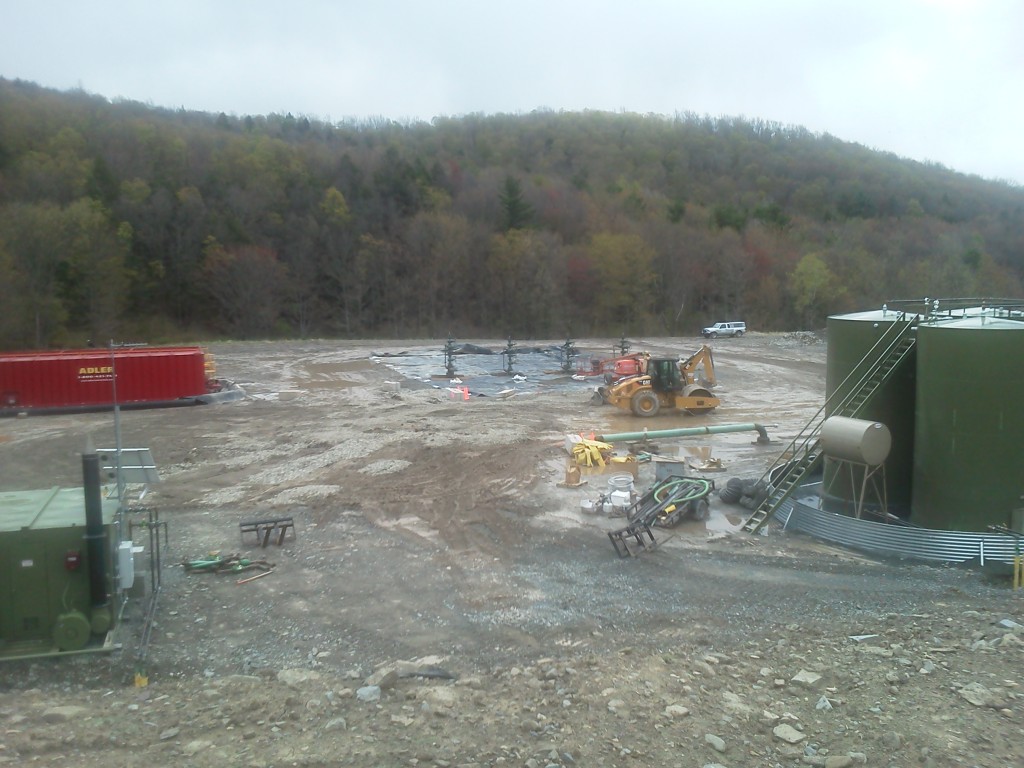
The well site was about the length and depth of two football fields. The site had been completely clear-cut and had no vegetation growing on its mud surface. Their was a berm uphill of the site along the dirt road (I was standing on it when I took the picture above); however, oddly there was no berm downhill of the site where there was a small stream. One would think the runoff from this site should not be going into that stream. There was no other fencing or security around the well site. The site had a compressor, several dehydrators, and a few holding tanks (I am not sure if these contained clean water, waste water, or natural gas). I was surprised to see there was no fracking waste water containment pool, but then I learned that the containment pools had been banded in this area as a result of their leaking and environmental damage.
I was glad to hear the fracking wastewater pools had been eliminated in this area; however, I wish the ban had happened from the beginning, rather than after the environmental harm had already occurred. This is a good example of how this industry is allowed to “learn on the job” with regard to environmental damage, as the fracking industry is exempt from most of this country’s important environmental protection legislation. Here is a list of some of the legal exemptions for the fracking industry: The Clean Air Act, The Clean Water Act, The Safe Drinking Water Act, National Environmental Policy Act, Resource Conservation and Recovery Act, Comprehensive Environmental Response, Compensation, and Liability Act, and the Toxic Release Inventory under the Emergency Planning and Community Right-to-Know Act. You can see a description of these acts HERE.
Many people, both for and against the fracking industry, claim these exemptions are in place because without them, the fracking industry would not be profitable. The natural gas industry is a speculative business, just like the oil industry, so some of the wells they dig produce a lot of gas, and some of them produce very little gas. The net result (the hope for the industry and those who receive royalties from it, and this is where the speculation comes in) is the amount of natural gas extracted and sold across all the companies assets will produce more revenue than the total cost they incurred to dig all those wells. This speculation is one reason why all fossil fuels are so destructive of the environment: the land (or ocean) needs to be continuously brutalized in a very concentrated area in order for the companies to achieve a profitable return for their efforts.
This takes me back to the fracking well site I was standing on in the picture above. In every direction (north, south, east, and west) there was a huge clear cut swath of forest (these looked to be between 100 and 200 feet wide) running as far as the eye could see. These swathes were where the pipelines were laid to connect this well site to the larger natural gas infrastructure in the area (see photos below).
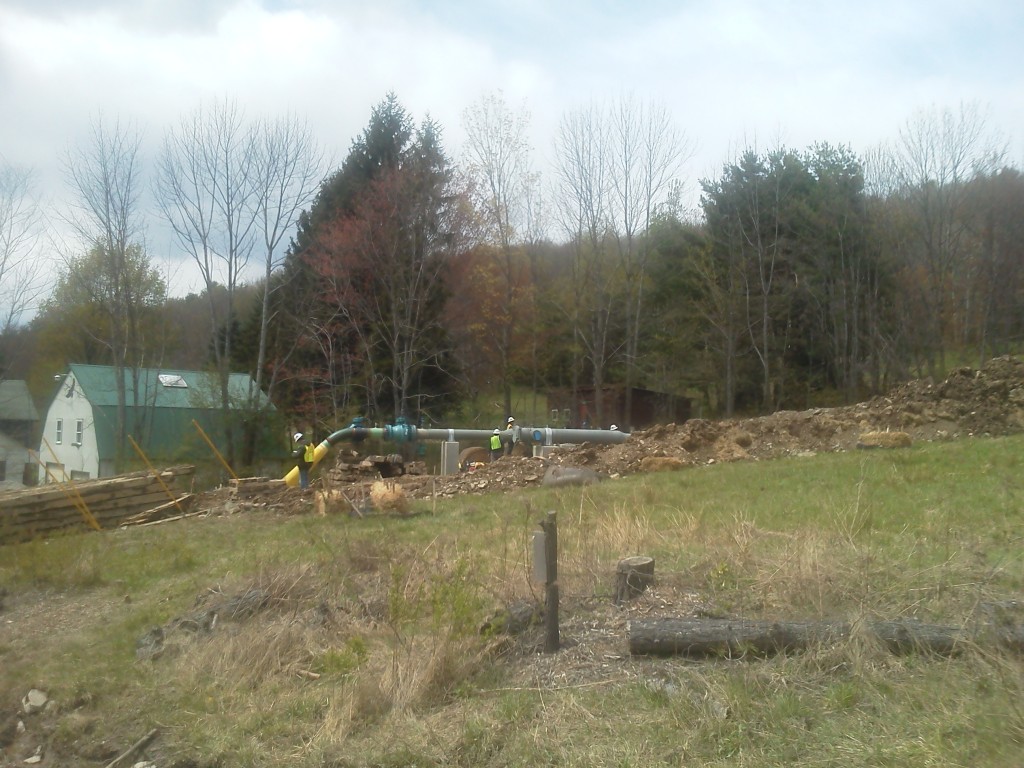
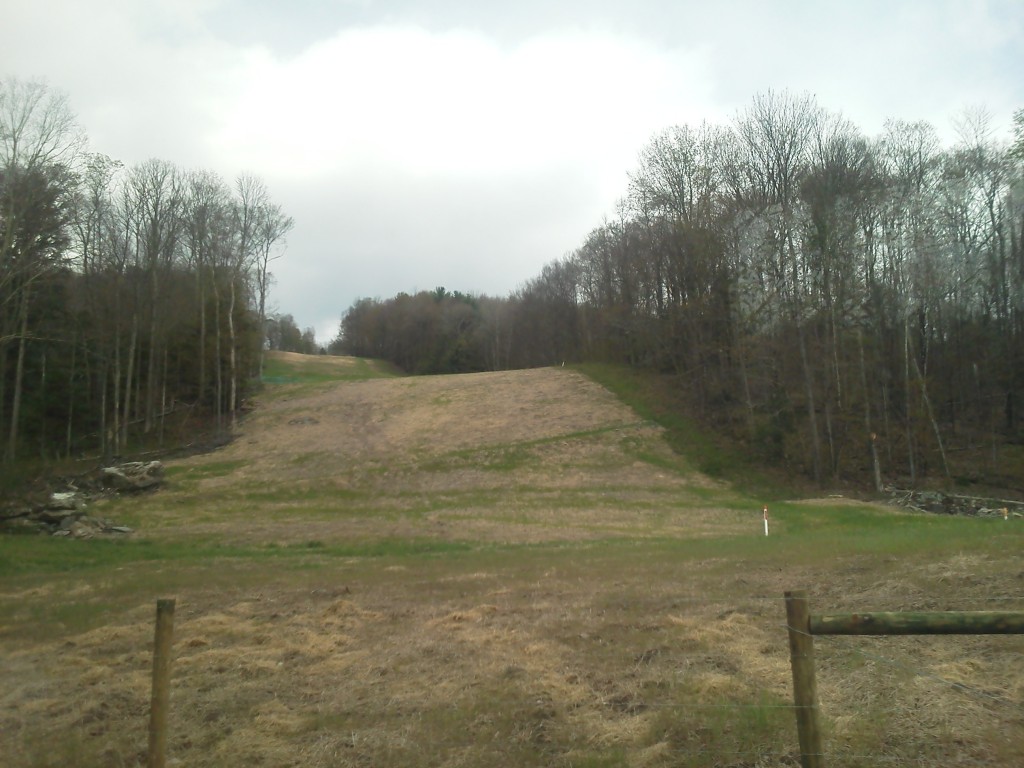
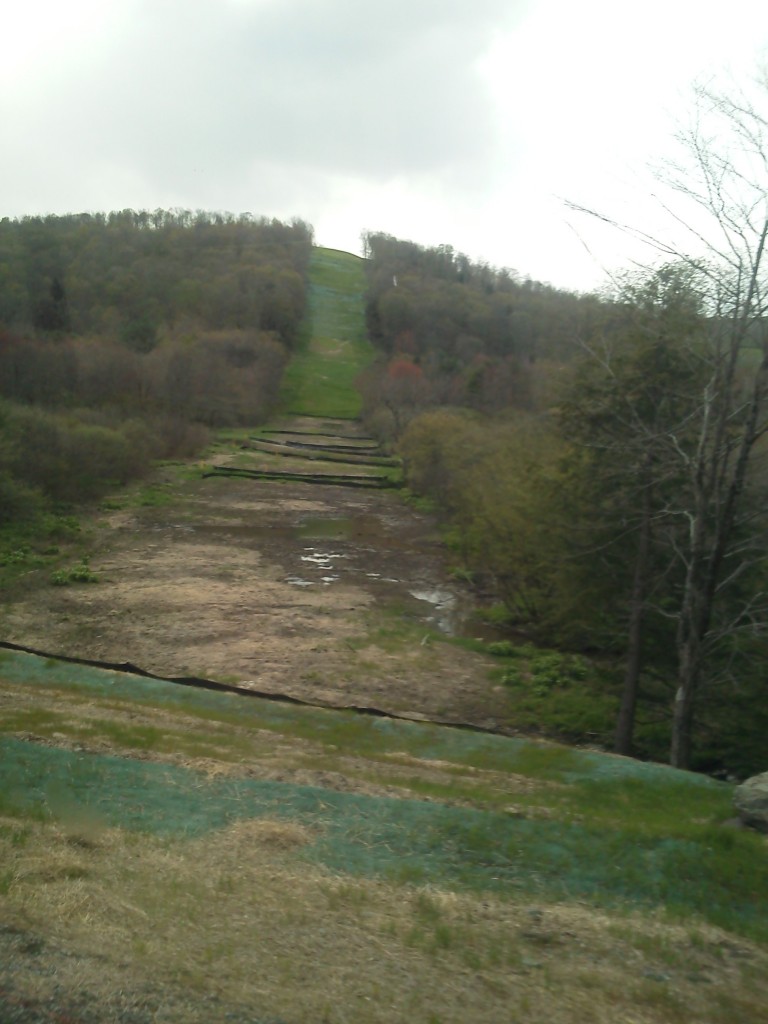
The fracking pipeline infrastructure is necessary because it is too costly (and dangerous) to truck the natural gas all over the countryside; additionally, the local citizenry has complained about the truck traffic at all hours of the night, as the completed wells pump gas 24 hours a day. As a result, the entire area (not just the well sites) are blighted with clear cut areas where thousands of trees have been removed. I am not sure why they need to cut a 100-200 foot swath through the forest to support a 13 inch pipeline; however, I assume it has something to do with the area needed to bring in a response team if there was ever a pipeline rupture.
The next well site I traveled to was on a 600-acre farm owned by a local family named Depuy. The farm has four completed wells on it and a separate compressor station (see photo below). 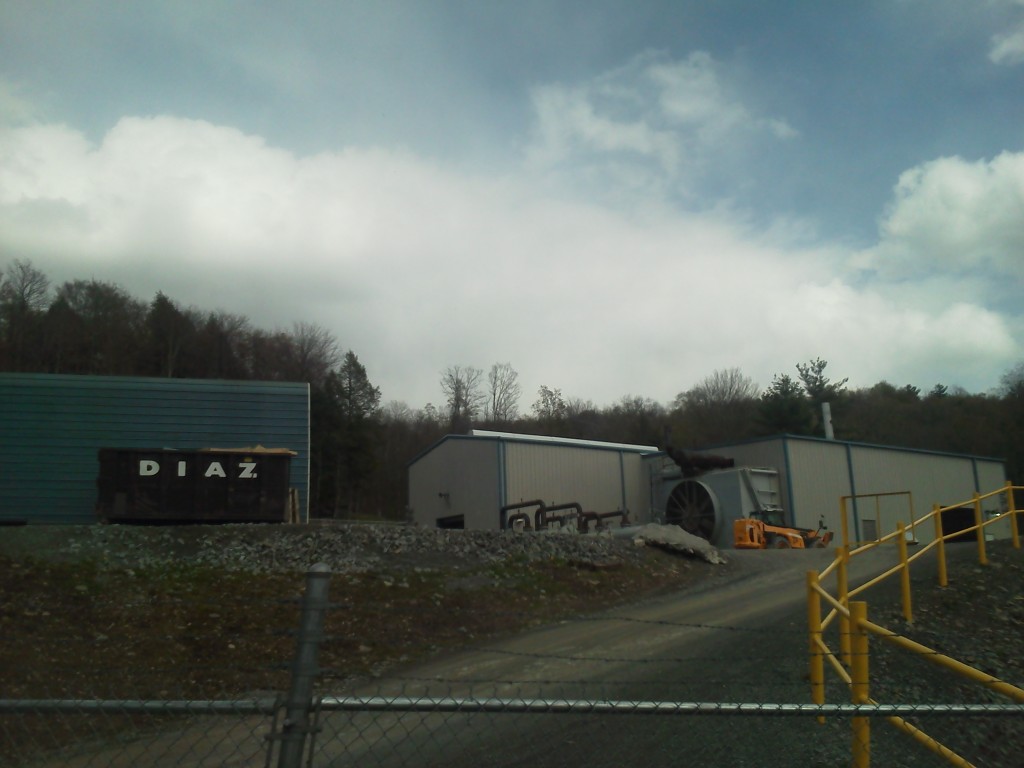 The owner approached us and told us we should clear out of the area. We told her we were standing on public (dirt) roads, and we had a right to be there and to take photographs as long as we did not step on her property. The tour guide I was with spoke to her and asked her what she thought about the presence of the gas industry in the area. The owner said it was wonderful, and she was glad to see America taking charge of its energy independence. She told us we would need to get out of the area or it would become “dangerous.” She then told us we need to get our facts straight. I was struck by this comment, as we had not expressed to her what our opinions were nor had we explained to her what we understood the “facts” to be.
The owner approached us and told us we should clear out of the area. We told her we were standing on public (dirt) roads, and we had a right to be there and to take photographs as long as we did not step on her property. The tour guide I was with spoke to her and asked her what she thought about the presence of the gas industry in the area. The owner said it was wonderful, and she was glad to see America taking charge of its energy independence. She told us we would need to get out of the area or it would become “dangerous.” She then told us we need to get our facts straight. I was struck by this comment, as we had not expressed to her what our opinions were nor had we explained to her what we understood the “facts” to be.
According to the U.S. Energy Information Administration (EIA), in 2011, the United States consumed approximately 24.37 Tcf (trillion cubic feet) of natural gas in seven end-uses: electric power generation (31%), industrial (28%), residential (19%), commercial (13%), lease and plant fuel consumption (6%), pipeline and distribution (3%), vehicle fuel (<1%). The EIA estimates that there are 2,214 (Tcf) of natural gas that is technically recoverable in the United States (about 92 years at current annual consumption levels). Of the total, an estimated 273 Tcf are proved reserves, which includes 60 Tcf of shale gas (<2.5 years at current annual consumption rates); however, according to the EIA’s Annual Energy Outlook of 2012, shale gas is expected to be 49% of annual U.S. natural gas production by 2035. These expectations are based largely on the assumed success for the fracking industry.
To provide a little perspective, as of 2008, the major proven resources of global natural gas (in billion cubic meters) totaled 175,400. The top 10 countries that make up this total are: 44,650 (Russia), 26,850 (Iran), 25,630 (Qatar), 7,167 (Saudi Arabia), 6,017 (United Arab Emirates), 5,977 (USA), 5,210 (Nigeria), 4,708 (Venezuela), 4,502 (Algeria), and 3,170 (Iraq). The U.S. is in the top ten, but we are by no means one of the largest global players in this industry; nonetheless, if the expectations (production levels) of the EIA and the fracking industry prove correct, the U.S. will have enough natural gas to accommodate its annual use and produce a relatively small export. One of the problems we are encountering now is that the natural gas industry is already trying to export natural gas having not sufficiently proven that the EIA fracking expectations will be met, that these quantities will first serve to satisfy the growing American annual consumption (the American energy independence argument), and that natural gas can be safely exported without further major destruction of our environment.
Lastly, there is the issue of price. If the supply of natural gas rises in this country and exceeds the U.S. annual consumption (as the EIA expects it will), then natural gas prices should continue to stay low; however, if the natural gas industry exports more than their surplus beyond the U.S. annual consumption, then their will be a natural gas shortage, and prices will rise; moreover, there is nothing to stop the natural gas industry from selling its product to the highest bidder, as all profit-driven companies do, unless our government puts the appropriate restrictions and/or tariffs on natural gas exports to ensure this does not happen.
One more point on natural gas statistics before I take you back to my trip in Pennsylvania. I would like speak a little on natural gas vehicles (NGVs), as I have heard some discussion around this industry growing, which may further effect the conclusions I have stated above. As of 2011, there were 14.8 million natural gas vehicles across the world, led by Iran with 2.86 million, Pakistan (2.85 million), Argentina (2.07 million), Brazil (1.70 million), and India (1.10 million). As of 2009, the U.S. had a fleet of 114,270 compressed natural gas vehicles (mostly buses) and 3,176 vehicles running on liquefied natural gas. This is the smallest usage of natural gas in the U.S. (<1% as I have stated above); however, some argue natural gas usage for vehicles may grow, as almost every petrol powered car (gasoline powered) can be converted to use natural gas as its fuel. I think this argument becoming a reality is very challenged given the power of the oil industry and the U.S. auto industry that works closely with it.
As of 2007 (this is the latest data that I can find…that I trust), there were 806 million cars and light trucks on the road worldwide, of which, 254.4 million passenger cars were in the United States. These numbers do not include commercial trucks, which consume about 20% of petrol use (gasoline and diesel) in our country. Petrol powered vehicles is a monster industry worldwide, and it is the dominant vehicle industry in the United States. In 2011, the United States consumed about 134 billion gallons (or 3.19 billion barrels) of gasoline. This was only 6% less than the record high of about 142.38 billion gallons (or 3.39 billion barrels) consumed in 2007. I don’t see the oil industry or the automotive industry, who would have to invest in the necessary changes to produce NGVs or retrofit its current petrol fleet, giving up their profits for the expansion of the natural gas industry, unless their hand is forced by our government, which again is highly unlikely.
Ok. Back to my trip in Pennsylvania. I left off when I was at the Depuy farm. From the Depuy Farm, we traveled to the homes of local residents who have been negatively affected by fracking in their area. We passed several homes with yards filled with signs protesting the gas industry and those elected officials who support it.
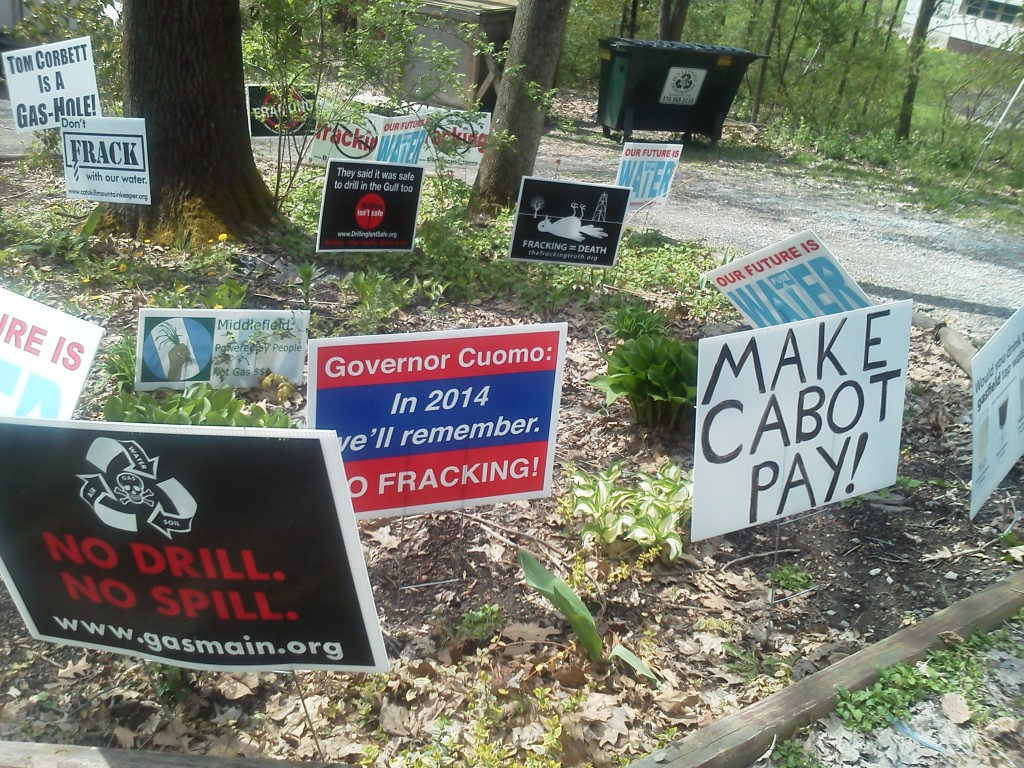
One resident we spoke to told us about the 2-year fight he and his family have been having with the local gas company: Cabot Oil & Gas. Cabot operates most of the fracking sites in Northeastern Pennsylvania. This resident was furious because his water has been bad for almost two-years. He told us his water was fine for the first few years while Cabot was drilling the in the area, but a few months after the wells went into operation and began pumping gas, he noticed his water changed. First he noticed his water was coming out in bursts. The bursts, which had never happened before the wells were drilled in the area, were pockets of methane that had entered his groundwater well and were escaping through his home’s plumbing. He reported the problem to Cabot and rather than testing the water to find out the specific issues, they installed a water filtration system in his home. Satisfied with this action, he told us he ignored the problem awhile longer, as most residents do, because they don’t want their monthly checks to stop coming from Cabot, but after his daughters began getting eczema and hives and feeling like they were going to pass out from showering in their home (even with the filtration system on), he decided to get his water tested.
Cabot promptly tested their water, free of charge, and said their was nothing wrong with the water in their home. Not being satisfied with that answer, the resident called in the local DEC and then the EPA. After a lot of foot-dragging, the local DEC office decided to come out to their home. Neither the DEC or the EPA tested their water, as they are not required to do so, being that they do not have the funding to follow up with every claim and they have no means to prove the fracking industry changed the water in the area; additionally, these government organizations cannot enforce water quality issues resulting from the fracking process, as the fracking industry is exempt from any criminal liabilities to damaged water as discussed above.
The local DEC office claims to have evaluated Cabot’s water test of this resident’s home; although, the family has never received a copy of Cabot’s water test. The DEC said the results of the water test were “within limits.” This family, not satisfied that “within limits” is the same as “completely safe for all uses,” approached local media and local environmental organizations. After some bad publicity for Cabot and the local DEC, the family was provided with a venting system for their groundwater well and a mobile water buffalo was placed on their property. This meant the family was now forced to get their water for all their home uses from the water buffalo outside in their driveway. The water buffalo was hooked up to the home water system; however, the family has since had to pay for the heating of the water buffalo (to prevent the water from freezing), and they constantly have to come out to the driveway to see how much water they have left to determine if they need a refill. Initially the EPA was paying to refill their water buffalo, but this has since stopped, and now they get most of their water donated from local water charities. The group I was with left this family about 30 gallons of water we had brought with us as donations.
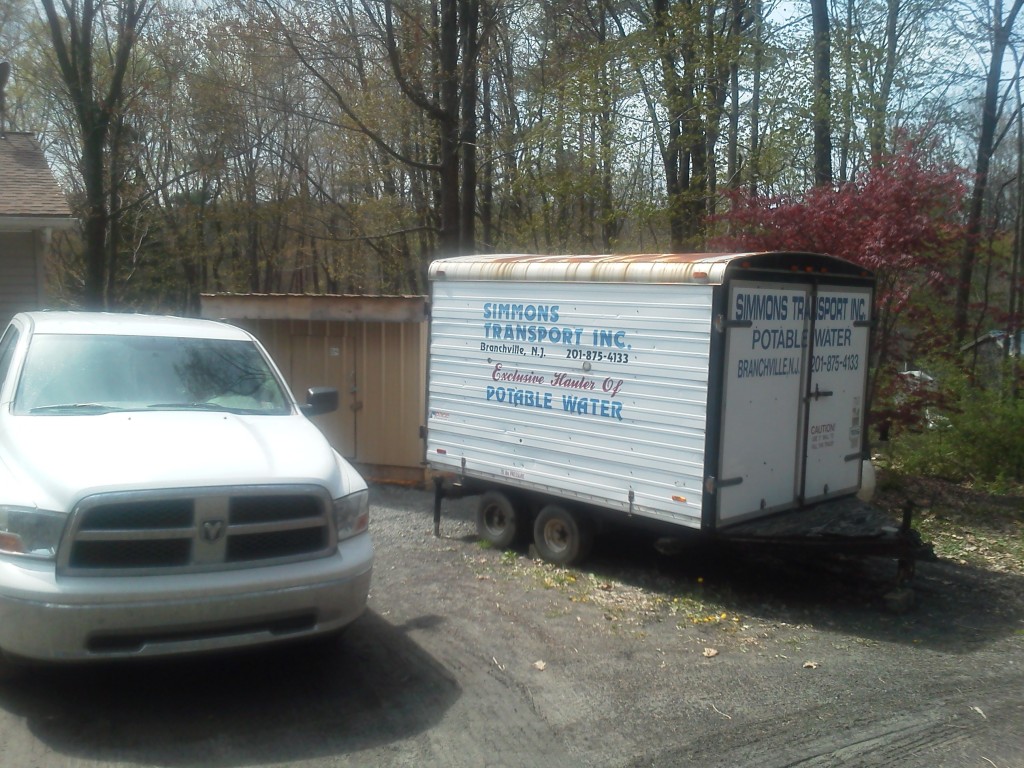
The brown shed is the water buffalo provided to this family after their well water caused health issues for family members.
To prove to our group there is still a problem with his ground water, this resident approached the PVC venting pipe that was protruding from his groundwater well and pulled off a small cap covering a hole that had been drilled in the pipe about two feet from the ground. He placed an empty milk carton over the hole for about 10 seconds, then he walked away from the pipe and placed a lighter over the opening of the milk carton. The milk carton almost shot out of his hand from the flame that protruded from it.
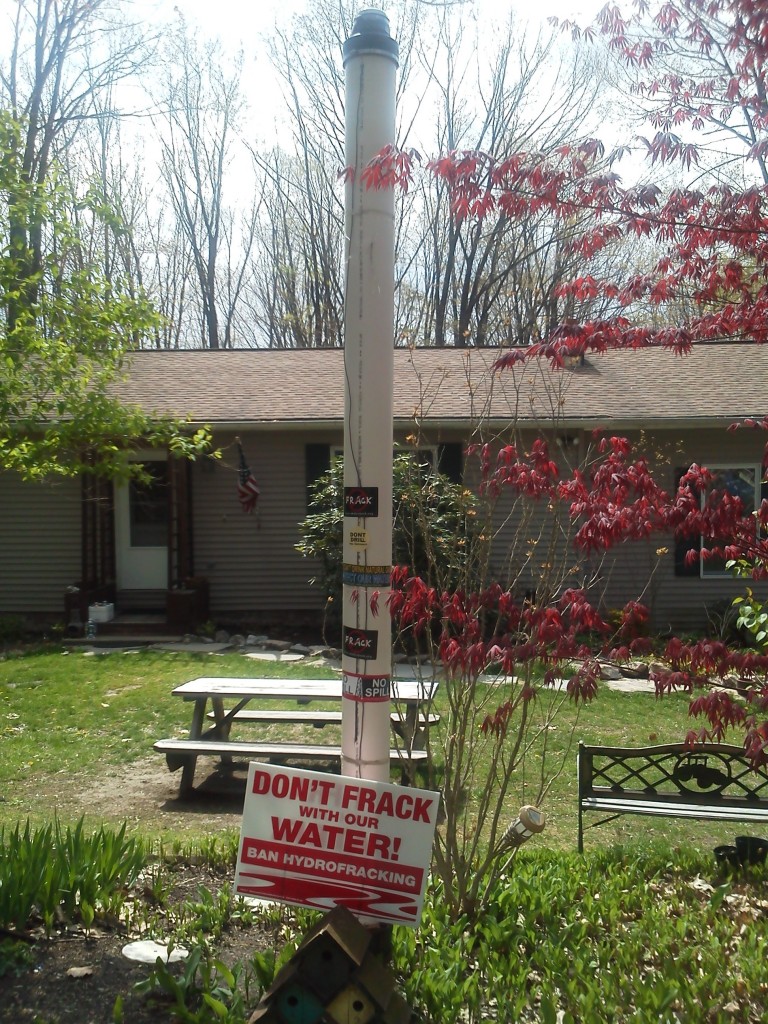
This resident can create a torch using only an empty milk carton and a lighter by trapping the air that rises from his groundwater well.
Ultimately, this resident was successful in getting a 9-mile moratorium on fracking around his home. He said this was both a blessing and a curse, as most of his neighbors (many former friends) have taken to cursing him and his family because they no longer receive their checks from Cabot. This speaks to the divided communities I mention in the opening of this article. This resident would like nothing more than to move away from the area he lives in; unfortunately, local realtors will not list his home because he does not have clean water, and many banks in the area are now refusing to insure or issue mortgages for homes near fracking sites. What this resident, and so many others have learned, is that the loss in property value far exceeds the amounts they have collected from the the gas companies.
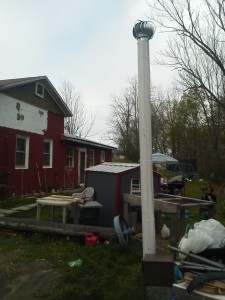
Another example of a venting system (this one over a chicken coup), installed by the gas company to vent the methane out of home's groundwater.
We visited many other homes with water problems, water buffaloes, and venting systems. Most of these residents are very poor, and it is obvious to me why the prospect of new income is very promising; unfortunately, this income is as speculative as the gas industry itself, it will only last as long as the gas in their wells, and what they are left with when the income and the wells dry up is hardly a fair deal. I was glad to hear some of these local residents have been hired by the gas companies, but as with everything else in the fracking process this comes at a cost. Those hired by the gas companies are told not to talk to environmentalists or anyone else who may be against fracking or they may lose their jobs; once again, this divides the community into solid camps of those who are for fracking and those who are against it.
If you have read this far, then you are still with me, and you care about this subject enough to learn as much as you can. Initially, I was biased against the fracking industry because a lot of smart environmentalists, who I have a lot of respect for, were voicing opposition to it; additionally, I have witnessed mounting testimony from regular citizens, who have been negatively impacted by fracking; nonetheless, I am glad I saw it first hand, and I encourage you to to do the same, if you are interested in this subject, particularly in light of the current debate in New York State concerning the approval of fracking. As I stated above, the industry will not succeed if left to self-monitor. Each time the industry makes an error because it has no proper oversight from our government, the industry will create another potential liability. These liabilities and the citizens they enrage will ultimately bring this industry down.
I would love to see a domestic energy industry create new jobs and new wealth for the communities they serve. I would also love to see a domestic energy industry create new energy resources that counter the powerful oil, coal, and nuclear industries. I would love to see a domestic energy industry that does not put harmful pollutants into our atmosphere, speeding up global warming and affecting the health of our citizens. Lastly, I would love to see a domestic energy industry that satisfies the growing annual U.S. energy need; therefore, decreasing our dependence on energy imports. I don’t think the gas companies that frack natural gas will be this industry. In my eyes, and many others, this industry is on a crash course with quick profit making in a down economy; thankfully, we do have the industry I describe above ready to take the lead: the solar industry. I will go in specifics about this industry in another post another time, but it’s important to note that the solar industry, with today’s technology and if maxed out across the U.S., has the ability to produce 40 times the annual U.S. energy need (each year). This is possible having limited effect on the environment, as we can use existing transmission lines to support the network; additionally, every citizen can benefit from this energy boom by putting solar on their own homes, decreasing their energy costs.
My final note on how I think this all ties together and how we can get ourselves on the right track…
Globalization is causing consolidated corporate power that exceeds even that of our sovereign governments. The pursuit of global profits has depressed global wages and dramatically increased the amount of resources devoted to producing consumer goods that have very little impact in the improvement of humanity. The private fracking industry in the U.S. is just one more industry looking to exploit labor and our natural resources to produce a profit. I don’t want to see another powerful private energy industry in the U.S. (including solar). In my opinion, access to the energy produced from the earth’s natural resources should be a human right, just like access to education, or healthcare; therefore, as in many industrialized countries in Asia, Africa, and Latin America (such as China, South Africa, and Brazil) the energy sector should be a non-profit public utility which is paid for through a national tax on all who consume that energy (individuals and corporations). One should be taxed based on one’s use, and that tax should extend to other sovereign nations for any energy we export.
A fully functional energy sector, benefiting the population it serves (not itself), is a prerequisite for growth in other industries; therefore, an energy sector focused on profits, will ultimately serve the needs of its owners and share holders over the population it serves. As we have already seen with the fracking industry, this leads to these companies not being concerned about the welfare of the citizens affected by their environmental damage and the division of communities they operate in.
For-profit global corporations, particularly those in the private U.S. energy sector, which are the wealthiest corporations in the world, use those profits to build power for their personal interests (more profits). This leads to the lobbying of our governments, advertising to our citizenry, and contributions/investments in other sectors as a means to further influence our culture and to consolidate power. In my opinion, the best way to combat these troubling actions is to strengthen the voice of our citizenry through education, public debate, and by draining our governments of money from corporate lobbying. Corporations should not have a voice in our electoral process, which will empower citizenry and allow public voices to command the stage rather than corporate cash.
Do you really want to see the beautiful landscapes and the wonderful communities of New York State, or any other state, torn apart by the fracking industry? To see just how completely this industry is taking over Pennsylvania, here again is this great map from independentwatertesting.com.


